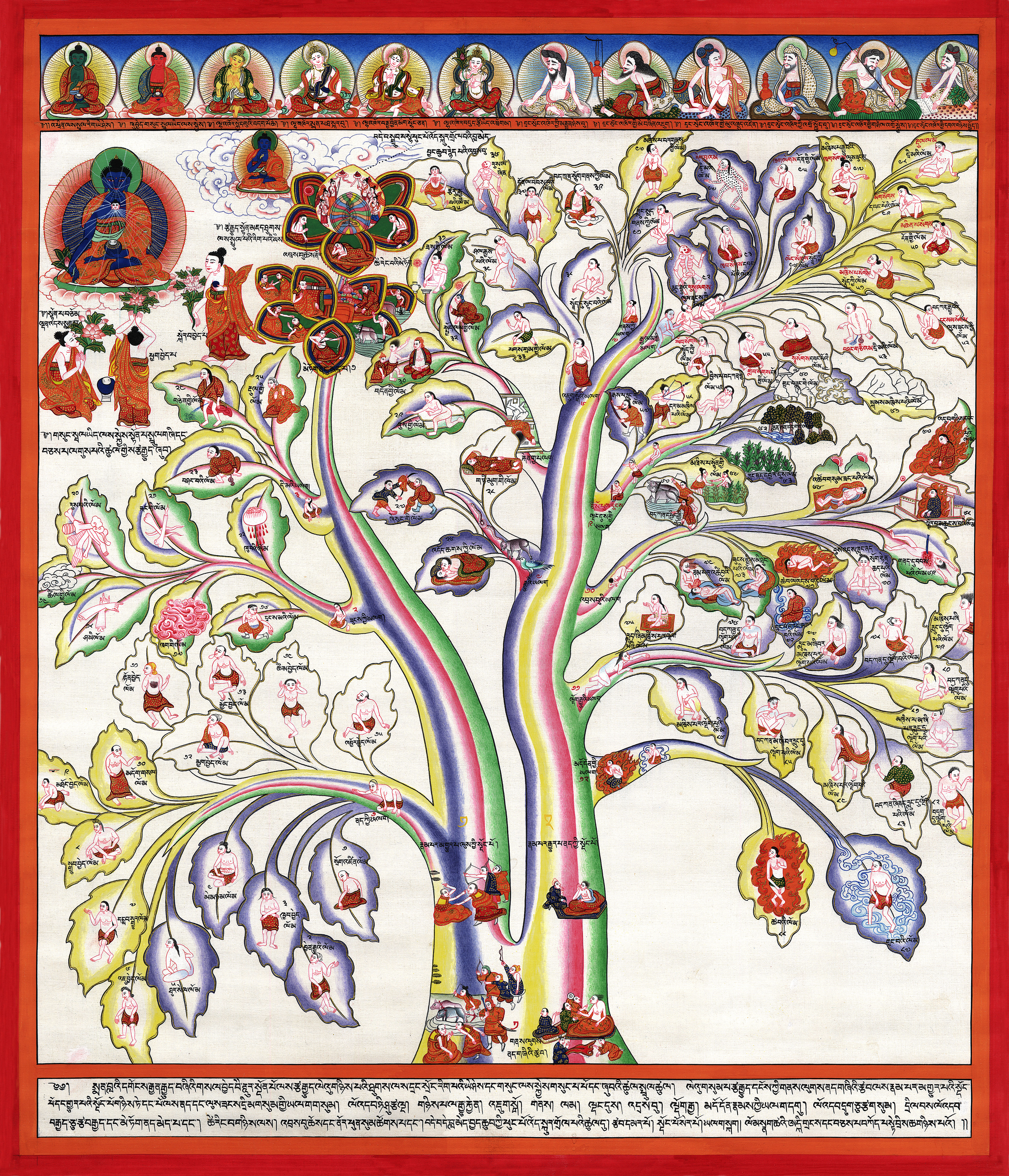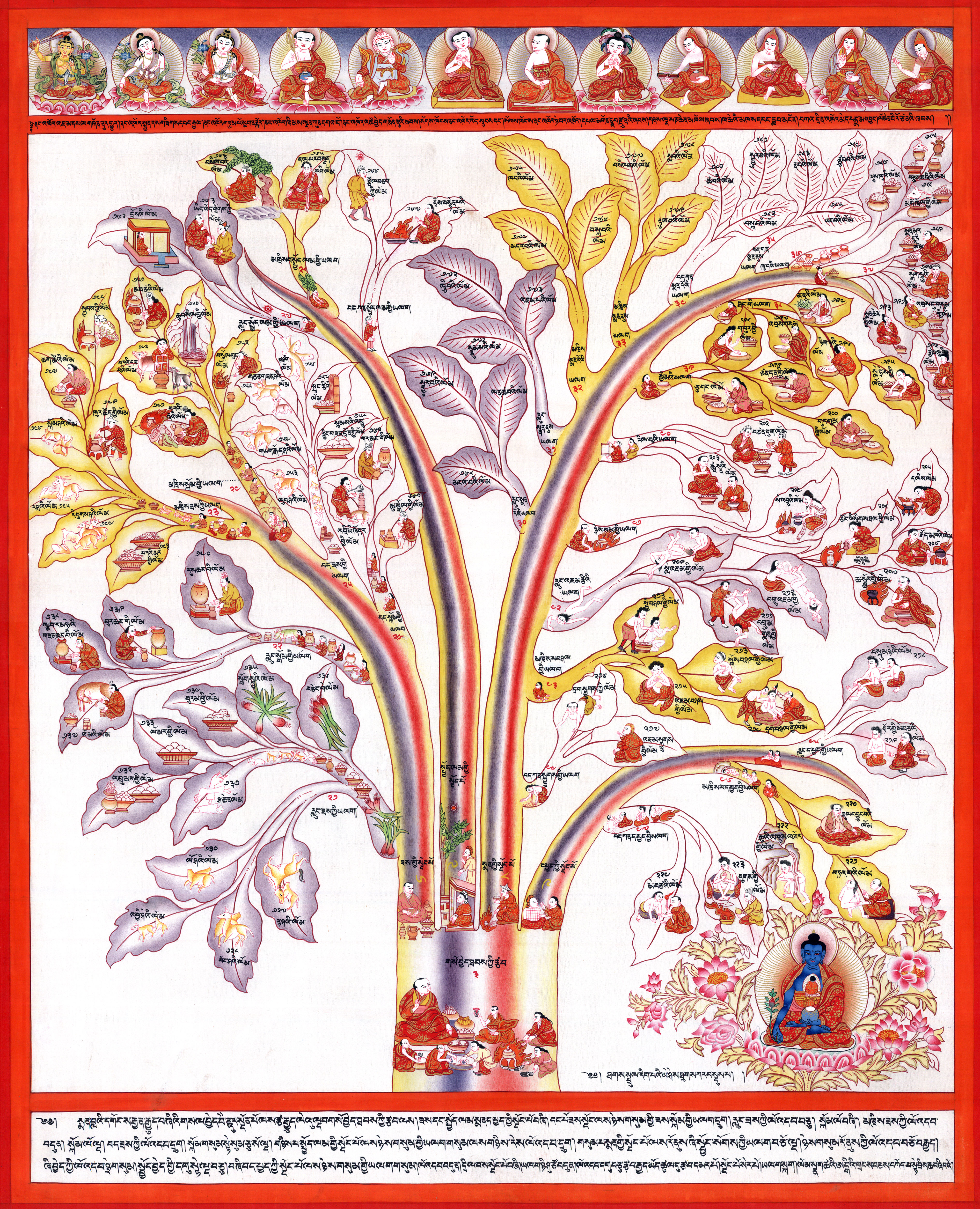Healing in the Diaspora
The Root Tantra is the first of Four Tantras, rGyud bZhi, and describes the Tibetan medical system as a tree. This tree is based in three routes of approaching wellbeing, from determining whether the body is healthy or ill, through the three types evaluation, to a variety of complementary and alternative cures. Click on any of the root tantras below for more information.
History of Tibetan Medicine: Root Tantras
The practice of Sowa Rigpa , Traditional Tibetan Medicine, is founded in the rGyud bZhi ,or Four Tantras, a series of ancient texts protected by monasteries for centuries. The medical system is conceptualized as a fig tree, a strong trunk split into branches bearing the fruits of an isolated and altruistic method. As outlined in the first sutra, the Root Tantra, the medical sytem is organized into 9 paths towards understanding wellbeing. Each of these roots illustrates an approach to determining, evaluating, or curing bodies between health and sickness. Grouped into trunks of 2, 3, and 4, each stem addresses a separate portion of physical, emotional, and spiritual wellbeing, illustrated through ancient scientific and artistic techniques unique to Tibet.
An extraordinarily intricate model of ancient healing, these visual tools have educational, practical, and decorative value; not only are they used to train generations of Tibetan physicians in medical institutions from Dharmasala to Kathmandu, they are frequently relied upon in meditation alongside mantras, and the market for the thangkas sold as high-quality prints has blossomed in recent years. Furthermore, their organization shares structural elements with data and genetic trees, communicating complex concepts in a universally comprehensible visual language. The series of 79 Medical Thangkas referred upon for this project were painted by Romio Shrestha, an master of Tibetan, Nepalese, and Indian art, who was visited at the age of five by two monks who told him he was the reincarnation of Tibetan thangka painter Arniko. In 1959, the thangkas demonstrate how a modern practice is founded, both in concept and communication, on the artistic, spiritual, cosmological, and philosophical approach of Tibetan Buddhist Medicine. Dr. Yangbum Gyal, esteemed scholar and adored physician of Tibetan Buddhist Medicine, takes care of patients across the midwest from numerous backgrounds and socioeconomic conditions. Between helping his regular and first-time clients at the Life Force Healing Center in Northern Chicago, he refers to the diagrams across his walls as operational roadmaps for an empathetic and intuitive approach to healing.
The written form of Sowa Rigpa was protected in monasteries and revised by those educated in the school of medicine for centuries. These tantras became the epicenter of holistic health knowledge as it moved from Mediterranean origins through Eurasian plateaus, long before the concept was implemented in its modern Western form. As Buddhism adapted to the unique environment of altruistic life in high altitudes, the medical practice evolved as well. The rGyud bZhi , fundamental medical treatise of Tibet, is a cohesive manual of care based on translations by Ayurvedic physician Chandrananda of Kashmir, and was brought to Tibet by scholar Vairocana in the 8th century to the regent Songtsen Gyampo; spiritual components are largely based on the Mahayana Sutras of the Medicine Buddha. Many consider that the men of the Yuthok Yonten Gonpo lineage, Older and Younger, were responsible for the composition of the text; they were both known for their travels to nearby countries and relative motivations to document or spread the “art of healing” flourishing in Tibet. Regardless of the specific authorship, is it clear through the unified, complementary perspectives integrated in the rGyud bZhi and taught still today that this knowledge is based in ancient academic discourse between scholars of various origins around the Himalayan.
For more information, visit https://tibetanmedicine-edu.org/tmm/tm/tibetan-medicine/
Additionally, here are two more Medical thangkas in addition to the root tantras above. They are from the Dharmasala Centre as well, all images were sourced from the Dharmapala Thangka Centre, www.thangka.de. All images are available for purchase as high quality prints.
Palace of Bhaisajyaguru
https://thangka.de/Gallery-3/Medical/8-1/medical-big.jpg
Subtle body with channels
https://thangka.de/Gallery-3/Medical/8-12/medic-big.jpg
Sources
Hofer, T., Pa-saṅs-yon-tan, S., & Rubin Museum of Art. (2014). Bodies in balance: The art of Tibetan medicine . Rubin Museum of Art. American Museum of Natural History, Williamson, L., & Young, S. (2009). Body & spirit: Tibetan medical paintings . American Museum of Natural History, in association with University of Washington Press.
Yeshi Donden & Wallace, B. A. (2000). Healing from the source: The science and lore of Tibetan medicine . Snow Lion Publications.
Vincanne Adams, M. S., Alex McKay, Martin Saxer, Stephan Kloos, Vincanne Adams, R. D., Correlating biomedical and Tibetan medical terms in Amchi medical practice, . . . Craig, S. R. (2011). Medicine between science and religion: Explorations on Tibetan grounds . Berghahn Books.
Roberti di Sarsina, P., Ottaviani, L., & Mella, J. (2011). Tibetan medicine: a unique heritage of person-centered medicine. The EPMA journal , 2 (4), 385–389. https://doi.org/10.1007/s13167-011-0130-x
Fenner, Todd. “The Origin of the rGyud bzhi : A Tibetan Medical Tantra. ” In Tibetan Literature: Studies in Genre . Edited by Jos. Ignacio Cabez.n and Roger R. Jackson, 458-469. Ithaca, NY: Snow Lion Publications, 1996.



